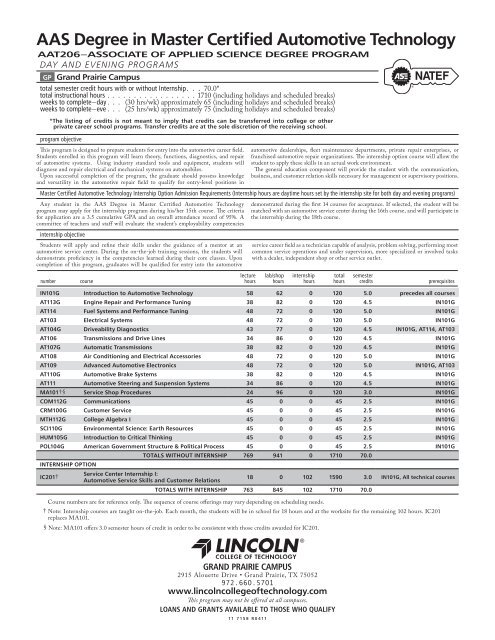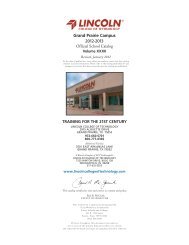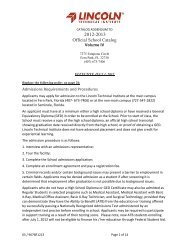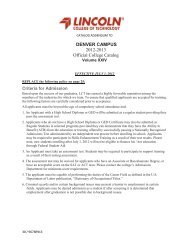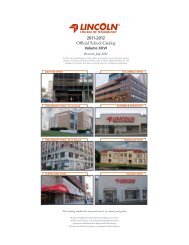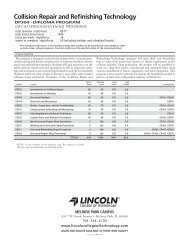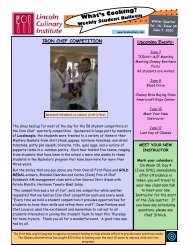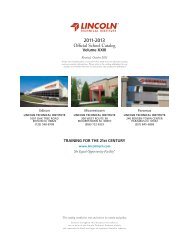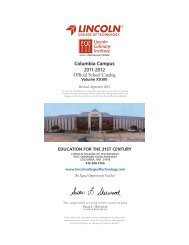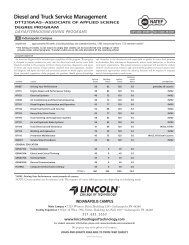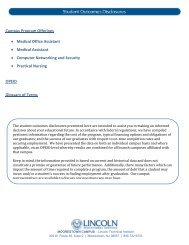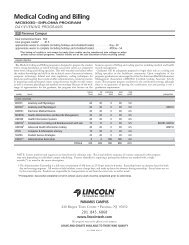to download the PDF - Lincoln Technical Institute
to download the PDF - Lincoln Technical Institute
to download the PDF - Lincoln Technical Institute
You also want an ePaper? Increase the reach of your titles
YUMPU automatically turns print PDFs into web optimized ePapers that Google loves.
AAS Degree in Master Certified Au<strong>to</strong>motive Technology<br />
AAT206 – Associate of Applied Science Degree PROGRAM<br />
day and Evening programs<br />
gp Grand Prairie Campus<br />
<strong>to</strong>tal semester credit hours with or without Internship. . . 70.0*<br />
<strong>to</strong>tal instructional hours . . . . . . . . . . . . . . . . . 1710 (including holidays and scheduled breaks)<br />
weeks <strong>to</strong> complete – day . . . (30 hrs/wk) approximately 65 (including holidays and scheduled breaks)<br />
weeks <strong>to</strong> complete – eve . . . (25 hrs/wk) approximately 75 (including holidays and scheduled breaks)<br />
*The listing of credits is not meant <strong>to</strong> imply that credits can be transferred in<strong>to</strong> college or o<strong>the</strong>r<br />
private career school programs. Transfer credits are at <strong>the</strong> sole discretion of <strong>the</strong> receiving school.<br />
program objective<br />
This program is designed <strong>to</strong> prepare students for entry in<strong>to</strong> <strong>the</strong> au<strong>to</strong>motive career field.<br />
Students enrolled in this program will learn <strong>the</strong>ory, functions, diagnostics, and repair<br />
of au<strong>to</strong>motive systems. Using industry standard <strong>to</strong>ols and equipment, students will<br />
diagnose and repair electrical and mechanical systems on au<strong>to</strong>mobiles.<br />
Upon successful completion of <strong>the</strong> program, <strong>the</strong> graduate should possess knowledge<br />
and versatility in <strong>the</strong> au<strong>to</strong>motive repair field <strong>to</strong> qualify for entry-level positions in<br />
au<strong>to</strong>motive dealerships, fleet maintenance departments, private repair enterprises, or<br />
franchised au<strong>to</strong>motive repair organizations. The internship option course will allow <strong>the</strong><br />
student <strong>to</strong> apply <strong>the</strong>se skills in an actual work environment.<br />
The general education component will provide <strong>the</strong> student with <strong>the</strong> communication,<br />
business, and cus<strong>to</strong>mer relation skills necessary for management or supervisory positions.<br />
Master Certified Au<strong>to</strong>motive Technology Internship Option Admission Requirements (Internship hours are daytime hours set by <strong>the</strong> internship site for both day and evening programs)<br />
Any student in <strong>the</strong> AAS Degree in Master Certified Au<strong>to</strong>motive Technology<br />
program may apply for <strong>the</strong> internship program during his/her 15th course. The criteria<br />
for application are a 3.5 cumulative GPA and an overall attendance record of 95%. A<br />
committee of teachers and staff will evaluate <strong>the</strong> student’s employability competencies<br />
demonstrated during <strong>the</strong> first 14 courses for acceptance. If selected, <strong>the</strong> student will be<br />
matched with an au<strong>to</strong>motive service center during <strong>the</strong> 16th course, and will participate in<br />
<strong>the</strong> internship during <strong>the</strong> 18th course.<br />
internship objective<br />
Students will apply and refine <strong>the</strong>ir skills under <strong>the</strong> guidance of a men<strong>to</strong>r at an<br />
au<strong>to</strong>motive service center. During <strong>the</strong> on-<strong>the</strong>-job training sessions, <strong>the</strong> students will<br />
demonstrate proficiency in <strong>the</strong> competencies learned during <strong>the</strong>ir core classes. Upon<br />
completion of this program, graduates will be qualified for entry in<strong>to</strong> <strong>the</strong> au<strong>to</strong>motive<br />
service career field as a technician capable of analysis, problem solving, performing most<br />
common ser vice operations and under supervision, more specialized or involved tasks<br />
with a dealer, inde pendent shop or o<strong>the</strong>r service outlet.<br />
lecture lab/shop internship <strong>to</strong>tal semester<br />
number course hours hours hours hours credits prerequisites<br />
IN101G Introduction <strong>to</strong> Au<strong>to</strong>motive Technology 58 62 0 120 5.0 precedes all courses<br />
AT113G Engine Repair and Performance Tuning 38 82 0 120 4.5 IN101G<br />
AT114 Fuel Systems and Performance Tuning 48 72 0 120 5.0 IN101G<br />
AT103 Electrical Systems 48 72 0 120 5.0 IN101G<br />
AT104G Driveability Diagnostics 43 77 0 120 4.5 IN101G, AT114, AT103<br />
AT106 Transmissions and Drive Lines 34 86 0 120 4.5 IN101G<br />
AT107G Au<strong>to</strong>matic Transmissions 38 82 0 120 4.5 IN101G<br />
AT108 Air Conditioning and Electrical Accessories 48 72 0 120 5.0 IN101G<br />
AT109 Advanced Au<strong>to</strong>motive Electronics 48 72 0 120 5.0 IN101G, AT103<br />
AT110G Au<strong>to</strong>motive Brake Systems 38 82 0 120 4.5 IN101G<br />
AT111 Au<strong>to</strong>motive Steering and Suspension Systems 34 86 0 120 4.5 IN101G<br />
MA101†§ Service Shop Procedures 24 96 0 120 3.0 IN101G<br />
COM112G Communications 45 0 0 45 2.5 IN101G<br />
CRM100G Cus<strong>to</strong>mer Service 45 0 0 45 2.5 IN101G<br />
MTH112G College Algebra I 45 0 0 45 2.5 IN101G<br />
SCI110G Environmental Science: Earth Resources 45 0 0 45 2.5 IN101G<br />
HUM105G Introduction <strong>to</strong> Critical Thinking 45 0 0 45 2.5 IN101G<br />
POL104G American Government Structure & Political Process 45 0 0 45 2.5 IN101G<br />
Internship Option<br />
IC201†<br />
TOTALS WITHOUT INTERNSHIP 769 941 0 1710 70.0<br />
Service Center Internship I:<br />
Au<strong>to</strong>motive Service Skills and Cus<strong>to</strong>mer Relations<br />
18 0 102 1590 3.0 IN101G, All technical courses<br />
TOTALS WITH INTERNSHIP 763 845 102 1710 70.0<br />
Course numbers are for reference only. The sequence of course offerings may vary depending on scheduling needs.<br />
† Note: Internship courses are taught on-<strong>the</strong>-job. Each month, <strong>the</strong> students will be in school for 18 hours and at <strong>the</strong> worksite for <strong>the</strong> remaining 102 hours. IC201<br />
replaces MA101.<br />
§ Note: MA101 offers 3.0 semester hours of credit in order <strong>to</strong> be consistent with those credits awarded for IC201.<br />
GRAND PRAIRIE CAMPUS<br />
2915 Alouette Drive • Grand Prairie, TX 75052<br />
972.660.5701<br />
www.lincolncollegeoftechnology.com<br />
This program may not be offered at all campuses.<br />
loans and grants available <strong>to</strong> those who qualify<br />
11 7158 R0411
course descriptions<br />
AAS Degree in Master Certified Au<strong>to</strong>motive Technology – AAT206 Degree Program<br />
IN101G – Introduction <strong>to</strong> Au<strong>to</strong>motive Technology<br />
120 Contact Hrs (58 Lecture, 62 Lab/Shop); 5.0 Credits<br />
This course has been developed <strong>to</strong> provide <strong>the</strong> student with a formal<br />
introduction <strong>to</strong> <strong>the</strong> au<strong>to</strong>motive industry. Students will be presented with<br />
an overview of <strong>the</strong> various job opportunities available in <strong>the</strong> au<strong>to</strong>motive<br />
industry. A general overview and understanding of <strong>the</strong> various au<strong>to</strong>motive<br />
systems as well as industry certifications will be discussed. Emphasis and<br />
assessment of life skills and cognitive skills will help <strong>to</strong> ensure <strong>the</strong> students<br />
success throughout this course and <strong>the</strong> remainder of <strong>the</strong> au<strong>to</strong>motive training<br />
program.<br />
Students will learn how <strong>to</strong> interpret written reference material <strong>to</strong> include<br />
textbook, service manuals, dictionaries, and etc.; properly communicate<br />
in <strong>the</strong> workplace; properly use safety equipment, clothing, and materials;<br />
properly select <strong>the</strong> correct hand, power, and diagnostic <strong>to</strong>ols for <strong>the</strong><br />
task; and properly use measurement <strong>to</strong>ols such as rulers, dial indica<strong>to</strong>rs,<br />
micrometer, and calipers.<br />
IN101G must precede all au<strong>to</strong>motive/diesel courses.<br />
AT113G – Engine repair and performance tuning<br />
120 Contact Hrs (38 Lecture, 82 Lab/Shop); 4.5 Credits<br />
The focus of this course is <strong>to</strong> provide <strong>the</strong> student with a detailed study of<br />
<strong>the</strong> modern internal combustion gasoline engine from <strong>the</strong> basic principles<br />
of design and operation <strong>to</strong> inspection, precision measurement, fitting, and<br />
reconditioning, <strong>to</strong> include engine block, cylinder heads, valve train, cooling<br />
systems, coolants, lubricating systems, and engine lubricants. Students<br />
will learn how <strong>to</strong> complete repair orders containing cus<strong>to</strong>mer and vehicle<br />
information and corrective action. Students will learn how <strong>to</strong> research<br />
vehicle service information with computer and internet based electronic<br />
retrieval systems. Students learn how <strong>to</strong> diagnose various engine concerns<br />
through visual and audi<strong>to</strong>ry inspection. Students will properly disassemble,<br />
inspect, measure, troubleshoot, service, and reassemble a gasoline engine.<br />
Dual Overhead Cam (DOHC) engines are featured in this course with<br />
focus on cylinder heads and design, camshafts, and valve trains. Valve<br />
timing strategies are emphasized concerning increased performance.<br />
Students will learn how <strong>to</strong> properly select and install manufacturer’s and<br />
aftermarket bolt-on engine components <strong>to</strong> achieve optimum performance.<br />
Students will utilize computers and simulation software <strong>to</strong> select engine<br />
components and identify characteristics and benefits of various part<br />
combinations. Students test engine component combinations in a simulated<br />
environment prior <strong>to</strong> assembly. During engine assembly, students<br />
properly identify, select, and utilize a variety of parts <strong>to</strong> achieve desired<br />
enhancements. Students will setup and conduct engine testing utilizing a<br />
dynamometer <strong>to</strong> demonstrate increased output and performance.<br />
Prerequisite: IN101G<br />
AT114 – Fuel Systems and performance tuning<br />
120 Contact Hrs (48 Lecture, 72 Lab/Shop); 5.0 Credits<br />
The student is presented with comprehensive coverage of late model<br />
gasoline fuel systems from <strong>the</strong> properties of gasoline <strong>to</strong> <strong>the</strong> by-products<br />
of combustion, including fuel supply and injection, air induction systems,<br />
and related emissions controls. Students will learn how <strong>to</strong> complete repair<br />
orders containing cus<strong>to</strong>mer and vehicle information and corrective action.<br />
Students will learn how <strong>to</strong> research vehicle service information with<br />
computer and internet based electronic retrieval systems. Emphasis is on<br />
troubleshooting, replacement, overhaul, and adjustment of fuel injection<br />
systems, including computerized engine management controls. Students<br />
will learn how <strong>to</strong> diagnose no-start/no-fuel problems on hot and cold<br />
engines. The use of scan <strong>to</strong>ols <strong>to</strong> retrieve trouble codes and five-gas analyzers<br />
<strong>to</strong> analyze emissions systems and combustion gases <strong>to</strong> determine necessary<br />
repairs and emissions law compliance is emphasized.<br />
Students will learn principles, operation and performance application of<br />
air induction systems including fac<strong>to</strong>ry and aftermarket turbochargers<br />
and superchargers. Students will learn <strong>to</strong> calculate injec<strong>to</strong>r and fuel system<br />
modification and sizing based on application and desired horsepower<br />
gain. Students will gain working knowledge of performance tuning<br />
and modifications <strong>to</strong> sport compact vehicles while ensuring compliance<br />
with emissions laws. The student is introduced <strong>to</strong> aftermarket engine<br />
performance and tuning computers and <strong>the</strong>ir purpose. Performance and<br />
tuning tests will be conducted on a chassis dynamometer <strong>to</strong> moni<strong>to</strong>r<br />
enhancements <strong>to</strong> vehicles including turbocharging, supercharging, and<br />
exhaust system modifications.<br />
Prerequisite: IN101G<br />
AT103 – Electrical Systems<br />
120 Contact Hrs (48 Lecture, 72 Lab/Shop); 5.0 Credits<br />
This course is designed <strong>to</strong> provide <strong>the</strong> student with practical <strong>the</strong>ory in<br />
basic and solid state circuitry, including body electrical systems, operation<br />
and service of au<strong>to</strong>motive s<strong>to</strong>rage batteries, au<strong>to</strong>mobile charging systems,<br />
starting systems, and lighting systems. Students will evaluate components<br />
using both conventional and electronic diagnostic equipment.<br />
Students will learn how <strong>to</strong> complete repair orders containing cus<strong>to</strong>mer<br />
and vehicle information and corrective action. Students will learn how<br />
<strong>to</strong> research vehicle service information with computer and internet based<br />
electronic retrieval systems. Students will learn how <strong>to</strong> diagnose basic<br />
electrical, charging, starting, and lighting circuits through <strong>the</strong> use of<br />
diagnostic equipment <strong>to</strong> include test lights, multimeters, and continuity<br />
testers.<br />
Prerequisite: IN101G<br />
AT104G – Driveability Diagnostics<br />
120 Contact Hrs (43 Lecture, 77 Lab/Shop); 4.5 Credits<br />
This course is designed <strong>to</strong> provide <strong>the</strong> student with knowledge of<br />
conventional and computerized engine control systems and scientific engine<br />
testing and tune-up. Students will receive detailed instruction on operating<br />
principles, testing, replacement and repair of <strong>the</strong> ignition systems.<br />
Students will learn how <strong>to</strong> complete repair orders containing cus<strong>to</strong>mer<br />
and vehicle information and corrective action. Students will learn how<br />
<strong>to</strong> research vehicle service information with computer and internet based<br />
electronic retrieval systems.<br />
Students will learn how <strong>to</strong> diagnose mechanical and electrical engine and<br />
control systems and determine needed action. Students will learn how <strong>to</strong><br />
use diagnostic scan <strong>to</strong>ols <strong>to</strong> retrieve engine, body, and o<strong>the</strong>r computerized<br />
control module trouble codes <strong>to</strong> determine condition, status, and determine<br />
needed action.<br />
Prerequisites: IN101G, AT114, AT103<br />
AT106 – Transmissions and Drive Lines<br />
120 Contact Hrs (34 Lecture, 86 Lab/Shop); 4.5 Credits<br />
This course is designed <strong>to</strong> provide <strong>the</strong> student with a comprehensive<br />
coverage of drive train components, including <strong>the</strong>ory, operating principles,<br />
service, and repair techniques of <strong>the</strong> clutch, differential and rear axles.<br />
Gearing, levers, hydraulics, component design, troubleshooting,<br />
replacement, disassembly, repair, service techniques, and assembly are<br />
emphasized. Manual and 4X4 transfer gear boxes, drive-shafts, U-joints,<br />
front and rear differentials, and manual transaxles are featured.<br />
Students will learn how <strong>to</strong> complete repair orders containing cus<strong>to</strong>mer<br />
and vehicle information and corrective action. Students will learn how<br />
<strong>to</strong> research vehicle service information with computer and internet based<br />
electronic retrieval systems. Students will learn how <strong>to</strong> diagnose, inspect,<br />
remove and replace a clutch. Students will learn how <strong>to</strong> diagnose, clean,<br />
inspect, disassemble, and reassemble a transmission/transaxle. Students<br />
will learn how <strong>to</strong> diagnose, inspect, remove, replace, and service front<br />
wheel-drive components and rear-wheel drive components.<br />
Prerequisite: IN101G<br />
AT107G – Au<strong>to</strong>matic Transmissions<br />
120 Contact Hrs (38 Lecture, 82 Lab/Shop); 4.5 Credits<br />
This course has been developed <strong>to</strong> provide <strong>the</strong> student with knowledge and<br />
skills needed <strong>to</strong> successfully diagnose and make needed repairs <strong>to</strong> au<strong>to</strong>matic<br />
transmissions and transaxles. Emphasis is placed on power-flow, operation,<br />
design, servicing equipment, troubleshooting, disassembly, inspection,<br />
replacement, assembly, testing, and adjustment.<br />
Students will learn how <strong>to</strong> complete repair orders containing cus<strong>to</strong>mer<br />
and vehicle information and corrective action. Students will learn how<br />
<strong>to</strong> research vehicle service information with computer and internet based<br />
electronic retrieval systems.<br />
Students will learn how <strong>to</strong> perform necessary diagnostic tests using special<br />
equipment including scan <strong>to</strong>ols <strong>to</strong> retrieve transmission/transaxle related<br />
trouble codes. Students will learn how <strong>to</strong> perform necessary service, repairs,<br />
and adjustments <strong>to</strong> au<strong>to</strong>matic transmissions and transaxles.<br />
Prerequisite: IN101G<br />
AT108 – Air Conditioning and Electrical Accessories<br />
120 Contact Hrs (48 Lecture, 72 Lab/Shop); 5.0 Credits<br />
This course is designed <strong>to</strong> provide <strong>the</strong> student with <strong>the</strong>ory and application<br />
of au<strong>to</strong>mobile air conditioning and heating systems. Students will also be<br />
presented with <strong>the</strong> operation of various au<strong>to</strong>mobile accessories <strong>to</strong> include:<br />
power windows, door locks, and seats, and air bag operation and service.<br />
Students will learn how <strong>to</strong> complete repair orders containing cus<strong>to</strong>mer<br />
and vehicle information and corrective action. Students will learn how<br />
<strong>to</strong> research vehicle service information with computer and internet based<br />
electronic retrieval systems. Students will learn how <strong>to</strong> diagnose abnormal<br />
operation of air conditioning and heating systems, remove and replace air<br />
conditioning and heating system components, and evacuate and recharge<br />
au<strong>to</strong>mobile air conditioning systems.<br />
Prerequisite: IN101G<br />
AT109 – Advanced Au<strong>to</strong>motive Electronics<br />
120 Contact Hrs (48 Lecture, 72 Lab/Shop); 5.0 Credits<br />
This course is designed <strong>to</strong> provide <strong>the</strong> student with a more in-depth<br />
knowledge of electrical and electronic principles, and advanced circuit<br />
applications. Students will learn about au<strong>to</strong>mobile computerized control<br />
systems as <strong>the</strong>y apply <strong>to</strong> engine and body control as well as transmission,<br />
suspension, braking systems, and o<strong>the</strong>r computerized systems. Computer<br />
operation, sensors, and actua<strong>to</strong>rs are emphasized.<br />
Students will learn how <strong>to</strong> complete repair orders containing cus<strong>to</strong>mer<br />
and vehicle information and corrective action. Students will learn how<br />
<strong>to</strong> research vehicle service information with computer and internet based<br />
electronic retrieval systems.<br />
Students will learn how <strong>to</strong> diagnose au<strong>to</strong>motive electrical and electronic<br />
circuits using a variety of diagnostic equipment <strong>to</strong> include digital vol<strong>to</strong>hm<br />
meters, continuity testers, test lights, graphing multimeters, and<br />
oscilloscopes. Students will learn how <strong>to</strong> use diagnostic scan <strong>to</strong>ols <strong>to</strong> retrieve<br />
trouble codes from vehicle computers and determine necessary repairs.<br />
Prerequisites: IN101G, AT103<br />
AT110G – Au<strong>to</strong>motive Brake Systems<br />
120 Contact Hrs (38 Lecture, 82 Lab/Shop); 4.5 Credits<br />
This course is designed <strong>to</strong> provide comprehensive coverage of design,<br />
operating principles, maintenance and service of <strong>the</strong> au<strong>to</strong>motive brake<br />
systems and traction control. Emphasis is placed on diagnosis and service<br />
of ro<strong>to</strong>rs and drums with measuring and resurfacing included. Anti-lock<br />
braking is covered from operating principles through diagnosis and service.<br />
Students will learn how <strong>to</strong> complete repair orders containing cus<strong>to</strong>mer<br />
and vehicle information and corrective action. Students will learn how<br />
<strong>to</strong> research vehicle service information with computer and internet based<br />
electronic retrieval systems. Students will learn how <strong>to</strong> diagnose mechanical<br />
and hydraulic problems within <strong>the</strong> vehicle braking systems. Students will<br />
learn how <strong>to</strong> diagnose computer control problems within <strong>the</strong> anti-lock and<br />
traction control systems.<br />
Prerequisite: IN101G<br />
AT111 – Au<strong>to</strong>motive Steering and Suspension<br />
Systems<br />
120 Contact Hrs (34 Lecture, 86 Lab/Shop); 4.5 Credits<br />
This course is designed <strong>to</strong> provide <strong>the</strong> student with detailed instruction of<br />
<strong>the</strong> design and operating principles, maintenance and service of au<strong>to</strong>mobile<br />
suspension and steering systems including steering geometry and alignment<br />
angles. Emphasis is placed on wheel alignment procedures, including<br />
computerized four-wheel alignment. Service and diagnostics are stressed<br />
including McPherson struts, rack and pinion steering systems, and tire<br />
design and applications. New technologies are covered <strong>to</strong> incorporate<br />
electronic steering, and in-depth coverage of computerized suspension<br />
systems.<br />
Students will learn how <strong>to</strong> complete repair orders containing cus<strong>to</strong>mer<br />
and vehicle information and corrective action. Students will learn how<br />
<strong>to</strong> research vehicle service information with computer and internet based<br />
electronic retrieval systems. Students will learn how <strong>to</strong> diagnose, inspect,<br />
and service steering system components using industry standard equipment.<br />
Students will learn how <strong>to</strong> diagnose inspect, remove and replace rear-wheel<br />
and front-wheel drive suspension component. Students will lean how <strong>to</strong><br />
perform alignments on front and rear wheel drive vehicles.<br />
Prerequisite: IN101G<br />
MA101 – Service Shop Procedures<br />
120 Contact Hrs (24 Lecture, 96 Lab/Shop); 3.0 Credits<br />
This course is designed <strong>to</strong> provide <strong>the</strong> students with exposure <strong>to</strong> an actual<br />
shops environment, procedures, and pro<strong>to</strong>col by applying prominent skills<br />
obtained in previous courses. Emphasis is placed on <strong>the</strong> removal and<br />
replacement of both engines and transaxles. Methods of securing future<br />
employment and <strong>the</strong> preparation of resumes are highlighted. Knowledge<br />
testing and skills application are highlighted among <strong>the</strong> <strong>to</strong>pics.<br />
Students will learn how <strong>to</strong> complete repair orders containing cus<strong>to</strong>mer<br />
and vehicle information and corrective action. Students will learn how<br />
<strong>to</strong> research vehicle service information with computer and internet based<br />
electronic retrieval systems.<br />
Prerequisite: IN101G<br />
IC201 – Service Center Internship I: Au<strong>to</strong>motive<br />
Service Skills & Cus<strong>to</strong>mer Relations<br />
120 Contact Hrs (18 Lecture, 102 Internship); 3.0 Credits<br />
In lieu of <strong>the</strong> Service Shop Procedures course, which facilitates <strong>the</strong> practice<br />
and practical application of lessons from previous technical courses, this<br />
optional course assigns <strong>the</strong> student <strong>to</strong> an actual repair facility outside <strong>the</strong><br />
school in conjunction with in-school course hours. Tasks and objectives<br />
associated with <strong>the</strong> Service Shop Procedures course are accomplished<br />
utilizing an actual working business environment in addition <strong>to</strong> course time.<br />
The student will learn how <strong>to</strong> function as a service technician in a real world<br />
environment while completing this course of study.<br />
Prerequisites: IN101G, All technical courses<br />
COM112G – Communications<br />
45 Contact Hrs (45 Lecture, 0 Lab/Shop); 2.5 Credits<br />
This course introduces students <strong>to</strong> effective strategies for oral and written<br />
communication. Topics presented include <strong>the</strong> communication process,<br />
types of documents, listening techniques, as well as English usage and<br />
mechanics and nonverbal communication. Upon successful completion of<br />
this course students should be able <strong>to</strong> identify <strong>the</strong> causes of communication<br />
success and failure, apply principles of grammar <strong>to</strong> writing, deliver oral<br />
presentations, and list steps <strong>to</strong> plan and develop effective documents.<br />
CRM100G – Cus<strong>to</strong>mer Service<br />
45 Contact Hrs (45 Lecture, 0 Lab/Shop); 2.5 Credits<br />
Many companies are looking for “well rounded” individuals who can exhibit<br />
good technical skills and exhibit <strong>the</strong> soft skills needed for both external<br />
cus<strong>to</strong>mers and internal cus<strong>to</strong>mers.<br />
This course is designed <strong>to</strong> provide a learning experience in cus<strong>to</strong>mer service<br />
and cus<strong>to</strong>mer relations. Students will gain a better understanding of what<br />
companies will expect of <strong>the</strong>m as employees and how <strong>the</strong>y can make an<br />
impact on business.<br />
Students will learn about cus<strong>to</strong>mer service so that <strong>the</strong>y can be more<br />
successful upon graduating and gaining a new position in <strong>the</strong>ir career field.<br />
MTH112G – College Algebra I<br />
45 Contact Hrs (45 Lecture, 0 Lab/Shop); 2.5 Credits<br />
This course is designed <strong>to</strong> introduce Algebra including solving equations<br />
and problem solving using Algebra. The student will work with graphs,<br />
linear equations and functions. The student will also use systems of<br />
equations <strong>to</strong> solve problems. Inequalities and problem solving using<br />
polynomial functions will be discussed and explored. The student will work<br />
with and solve equations using rational expressions.<br />
SCI110G – Environmental Science: Earth Resources<br />
45 Contact Hrs (45 Lecture, 0 Lab/Shop); 2.5 Credits<br />
This course is designed <strong>to</strong> provide students with a basic scientific overview<br />
of how nature works and how things in nature are interconnected. This<br />
course explores <strong>the</strong> study of <strong>the</strong> earth’s natural resources. Topics include <strong>the</strong><br />
study of how air, water, soil, natural energy, and <strong>the</strong> minerals are critical and<br />
related parts of <strong>the</strong> earth’s interconnected systems.<br />
HUM105G – Introduction <strong>to</strong> Critical Thinking<br />
Total Hrs: 45 (45 Lecture, 0 Lab/Shop); Credits: 2.5<br />
This course presents students with techniques <strong>to</strong> develop <strong>the</strong>ir critical<br />
thinking skills. Topics include <strong>the</strong> six sequential steps of critical thinking,<br />
<strong>the</strong> importance of language, ambiguity, structure of arguments and creative<br />
problem solving. Upon successful completion of this course students should<br />
be able <strong>to</strong> demonstrate an improvement in <strong>the</strong>ir ability <strong>to</strong> apply critical<br />
thinking skills <strong>to</strong> real world situations.<br />
POL104G – American Government Structure &<br />
Political Process<br />
45 Contact Hrs (45 Lecture, 0 Lab/Shop); 2.5 Credits<br />
This course is designed <strong>to</strong> provide students with <strong>the</strong> fundamentals of<br />
American government. The course defines politics, and identifies beliefs<br />
and ideologies. Students will explore <strong>the</strong> origins and structure of <strong>the</strong><br />
American government from colonialism <strong>to</strong> independence. The students<br />
will study <strong>the</strong> Declaration of Independence, Constitution, and methods<br />
for ratifying Constitutional change. Topics will also include defining<br />
Federalism, Civil Rights legislation and a brief study in political parties.<br />
Campaigns and Elections will also be discussed along with discussing <strong>the</strong><br />
impact that <strong>the</strong> Media can directly influence <strong>the</strong> political process.


